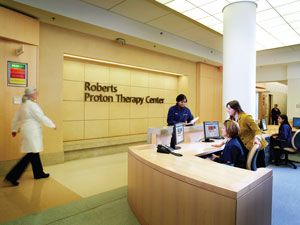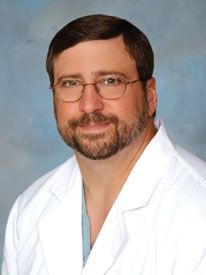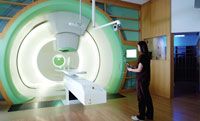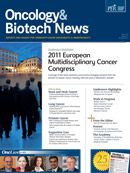Publication
Article
Oncology & Biotech News
University of Pennsylvania's Abramson Cancer Center: Leaders in Groundbreaking Therapies
Author(s):
Established in 1973 as the University of Pennsylvania's Cancer Center and subsequently renamed in 2002, the Abramson Cancer Center is a world leader in research, patient care, and education.

University of Pennsylvania's Abramson Cancer Center
Established in 1973 as the University of Pennsylvania’s Cancer Center and subsequently renamed in 2002, the Abramson Cancer Center is a world leader in research, patient care, and education.
The October 2008 opening of the 500,000-squarefoot Ruth and Raymond Perelman Center for Advanced Medicine has streamlined the efforts of Penn Medicine’s cancer program with seamless integration of services that creates a real-time model for optimizing diagnosis, therapy, and research.
Currently, Abramson’s clinical staff oversees 70,000 outpatient visits and more than 9000 admissions, and administers approximately 33,000 chemotherapy and 66,000 radiation treatments each year. The Center also is home to more than 400 basic, transitional, and clinical scientists.
Penn Medicine’s work in immunotherapy and proton therapy are but 2 examples of the cancer program’s position at the forefront of research aimed at bringing novel treatments to clinical practice.
Immunotherapy Research: Clinical Cell and Vaccine Production Facility
An impressive example of Penn Medicine’s cutting-edge bench-to-bedside cancer research is its work with biotherapeutics, in which autologous cells are harnessed and engineered to create highly targeted and personalized therapies with minimal autoimmune-mediated toxicity.
These endeavors have their roots in Penn Medicine’s Clinical Cell and Vaccine Production Facility (CVPF). There, novel vaccines are being produced and tested in the nation’s first pilot studies and phase I and II clinical trials. CVPF scientists work in concert with those of Penn’s Developmental Therapeutics program to further the investigation of new drugs and drug combinations, and translate insights into novel cellular therapies.
To this end, CVPF scientists perform processing on a range of cell types, including bone-marrow-derived CD4 and CD8 T lymphocytes, dendritic cells, and marrow stromal cells. The cells are expanded ex vivo, with or without genetic modification, before being reintroduced into the patient, either alone or in combination with other therapies, such as vaccines. Matched donor cells are used when autologous cells are not feasible.
“We are in the midst of tremendous basic research that we can take into our facility and translate to the bedside,” said Bruce L. Levine, PhD, associate professor of Pathology and Laboratory Medicine and director of Penn Medicine’s Clinical Cell and Vaccine Production program. “We’re highly integrated, with one hand bridging from the research lab and the other delivering the cells to the clinic.”
Applications are anticipated in hematologic malignancies; neuroblastoma; and breast, ovarian, and lung cancer; as well as nonmalignant targets such as HIV and osteogenesis imperfecta. Examples include “serial killer” T cell versus chronic lymphocytic leukemia (CLL), personalized ovarian cancer vaccines, and ductal carcinoma in situ (DCIS) vaccine.

Carl H. June, MD
Serial Killer T Cells versus CLL
In what is touted as a cancer treatment breakthrough 20 years in the making—and the marquee achievement of Penn’s cancer vaccine program—Abramson and Perelman School of Medicine researchers have demonstrated sustained remissions of up to 1 year in 3 patients with advanced CLL who were treated with genetically engineered versions of autologous T cells. The protocol involves modifying a patient’s harvested cells, and then infusing them back into the patient after chemotherapy. The findings are the first to demonstrate the use of gene-transfer therapy to create serial killer T cells aimed at malignant tumors.
Describing the preliminary results achieved with the first 3 patients, Carl H. June, MD, who led the work is also director of Translational Research and Abramson Center professor of Pathology and Laboratory Medicine, noted that “within 3 weeks the tumors had been blown away in a manner that was much more violent than we ever expected.”
While extremely preliminary, the findings are a source of great excitement and anticipation. “It worked much better than we thought it would,” said June.
The findings create what Penn scientists call a tumor-attack roadmap for the treatment of other malignancies, including cancers of the lung and ovaries, as well as myeloma and melanoma. Penn scientists are currently examining the feasibility of using the same technique for patients with pancreatic and other cancers.
Penn Medicine Cancer Program Timeline
1960
1973
1990
2002
Penn researchers lay the groundwork for cancer genetics after discovery of the “Philadelphia chromosome,” the first evidence of a genetic basis for the disease.
The University of Pennsylvania’s Cancer Center is formally established.
Researchers unravel the basic science behind the breast cancer drug Herceptin.
The Cancer Center is renamed the Abramson Cancer Center of the University of Pennsylvania in recognition of the philanthropic support of Leonard and Madlyn Abramson and family.
Continued below
Personalized Ovarian Cancer Vaccine
A vaccine manufactured from autologous blood cells and tumor protein has now been used successfully in a small number of patients to essentially “re-educate” the immune system to recognize ovarian tumor cells in the hopes of preventing recurrence. Similar to the approach being used for patients with CLL, this vaccine is intended specifically for patients whose disease has recurred after conventional therapies, and who would otherwise have few remaining treatment options.
Patients may receive more than 1 vaccine before the appropriate personalized treatment is identified, and may then require injections every few weeks over the course of a year or longer.

Brian J. Czerniecki, MD, PhD
DCIS Vaccine
Brian J. Czerniecki, MD, PhD, breast surgeon and co-director of the Rena Rowan Breast Center, developed an experimental vaccine against DCIS. This new vaccine is a source of hope for patients with this early stage of breast cancer. The vaccine, a HER2/ neu peptide-pulsed autologous dendritic cell vaccine made from the patient’s own cells, is given prior to surgery, in the hopes of bolstering the patient’s immune system early in the course of the disease to prevent recurrence.
To date, Penn physicians have treated 50 patients with the vaccine. While the vaccine is still in its infancy, preliminary results hold promise.
Proton Therapy
Penn Medicine’s role as a world leader in bringing novel therapies to clinical practice also is evidenced by the work being conducted at the Roberts Proton Therapy Center.

Proton Therapy 101
Depending on the individual patient’s circumstances, the course of proton therapy usually runs from 4 to 8 weeks, with the patient spending 5 days per week undergoing 20-minute treatment sessions.
The proton therapy protocol begins with an image of the patient’s tumor, obtained with computed tomography, magnetic resonance imaging, or positron emission tomography. That image is used to construct the filters and shields in the multileaf collimator, which precisely tunes the energy of the beam and shapes it to match the unique profile of the patient’s tumor, enabling delivery of the most effective dose to the exact location required. The Roberts Center is the world’s only facility to use this multileaf collimator technology.
The cancer-seeking proton beam originates inside a 220-ton cyclotron, which uses magnets to strip protons from the hydrogen atoms in water, accelerate them to their top speed and highest energy, and then direct them out of the cyclotron into a beamline. The proton beam is then channeled into 5 treatment rooms, 4 of which are equipped with a 90-ton gantry, a rotating steel structure that moves around the patient to aim the beam at any angle. The fifth treatment room is equipped with a fixed beam, around which the patient is positioned as needed.
Housed largely underground in a building connected to the Perelman Center, the 75,000-square-foot facility is the world’s largest that integrates both proton therapy and conventional radiation. When operating at full capacity, it is estimated that the Center will be able to treat approximately 200 patients each day.
Proton therapy is delivered in a beam in which the positively charged particles move at approximately 100,000 miles per second, precisely targeting and destroying the DNA of cancer cells and preventing their proliferation (see “Proton Therapy 101”).
Unlike the x-rays of conventional radiotherapy, which scatter and adversely affect surrounding tissue, protons give up their energy completely once they enter the tumor, precisely targeting a high dose of tumor-killing energy anticipated to cause less damage to healthy surrounding tissue. For this reason, it is hoped that proton therapy will enable treatment of difficult-toaccess tumors as well as those in close proximity to vital organs and structures, while decreasing the adverse effects and complications associated with conventional radiotherapy. Penn scientists also are hopeful that this highly targeted therapy will enable delivery of sufficiently high doses to prevent recurrence, ultimately resulting in improved cure rates.
The Role of Nursing in a New Frontier
As the most targeted and precise form of radiation therapy available, proton therapy offers promise for the treatment of a number of cancers. To date, Roberts Center clinicians have used the groundbreaking therapy to treat more than 300 patients with lymphomas, sarcomas, and cancers of the brain and spine, genitourinary system, gastrointestinal system, and lung. Treatment also has recently begun on a small number of patients with head and neck cancers. While sometimes used alone, optimal efficacy is achieved by using the therapy in conjunction with chemotherapy, conventional radiotherapy, and/or surgery.
“Many patients, and even some physicians, aren’t particularly well informed about proton therapy,” said proton intake and triage nurse Ellen Rash, RN, BSN, MS. “While the role of nurses remains, as always, to advocate, educate, and monitor patient care, the need for education has taken on new importance.”
Part of that education is aimed at patients’ misconceptions, said Rash, noting that patients often think this is a one-time, instantaneous treatment when, in reality, the protocol is similar to that of conventional radiation, involving several weeks of daily treatments. She added that the high-tech nature of the treatment is at once promising and, at times, intimidating to patients, even though the treatment itself is pain-free. For this reason, Rash encourages patients to supplement one-on-one education with Penn Medicine’s Web-based materials to help manage expectations and anxieties. A weekly education session and facility tour is available to patients, but Rash noted that most choose to get their information from the Internet.
Penn Medicine Cancer Program Timeline Continued
2004
2008
2009
2009
2011
Researchers develop the first animal model of pancreatic cancer that closely mimics disease progression in humans, and are able to develop and test new treatments and devise biomarkers for early detection.
The Perelman Center for Advanced Medicine opens its doors. It houses many of the Abramson Cancer Center’s services in hematology-oncology, radiation oncology, gynecologic oncology, and related clinical and psychosocial services.
The Roberts Proton Therapy Center opens, funded in part by Penn alumnus and Comcast owner Ralph J. Roberts and family.
The FDA approves a Penn-developed, minimally invasive surgery called TORS, used to reduce the trauma of surgical removal of head and neck malignancies.
Abramson Cancer Center researchers publish the first successful results of a gene therapy approach to cancer treatment, using modified autologous T cells to attack chronic lymphocytic leukemia.
Future Promise
Roberts Center scientists will remain at the forefront of exploration of the true potential and promise of this new therapy. They will continue to serve as a leader in clinical trials aimed at enhancing treatment efficacy, and at determining which cancers are best treated with proton therapy, the best ways to combine proton therapy and chemotherapy, and how best to use the therapy to improve surgical outcomes and reduce radiation-associated adverse effects.
“The excitement is palpable,” said Rash, “but at this stage we’re careful to express any claims conservatively.”
Laura Bruck is a Cleveland, Ohio-based freelance writer and editor who has specialized in healthcare reporting since 1987.































%20(2)%201-Recovered-Recovered-Recovered-Recovered-Recovered-Recovered-Recovered-Recovered-Recovered-Recovered-Recovered-Recovered-Recovered-Recovered-Recovered-Recovered-Recovered.jpg?fit=crop&auto=format)
%20(2)%201-Recovered-Recovered-Recovered-Recovered-Recovered-Recovered-Recovered-Recovered-Recovered-Recovered-Recovered-Recovered-Recovered-Recovered-Recovered-Recovered-Recovered.jpg?fit=crop&auto=format)
